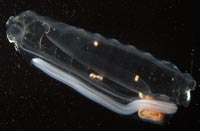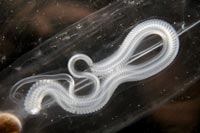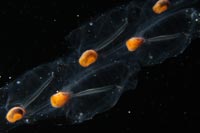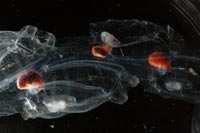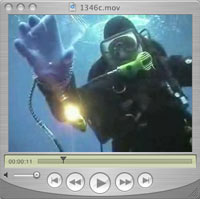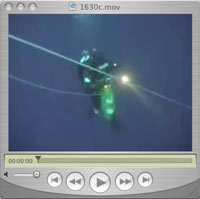|
By Larry Madin, Woods Hole Oceanographic Institution
A single salp, called a “solitary” of the species Salpa thompsoni, which is abundant near Antarctica. This one carries inside it five small pink crustaceans called amphipods. In the picture you can see the orange stomach and the white string of babies forming inside the salp. (Photo by Larry Madin, WHOI)
A close-up view of a solitary salp of the same species, with a long chain of babies that has looped around inside it. You can see groups of babies forming that are different sizes and stages of development. (Photo by Larry Madin, WHOI)
The chain of salps, called the “aggregate” stage, after it leaves the parent. The photo shows how they are attached, one to the other. The rows of orange-brown spots are the stomachs of the salps. (Photo by Larry Madin, WHOI)
Somewhere in our galaxy is a planet mainly covered by ocean. Most of the animals that live on the planet have evolved in water. One of these alien creatures looks like a transparent tube of Jell-O, about 4 inches (10 centimeters) long. Its body takes in water at the front end and pumps it out the back end, so that it pushes the animal along through the water, like a slow kind of jet engine. The creature takes its energy from small particles in the water, catching them in a strainer as the water goes through its body. The strainer is like a conveyer belt, always moving the bits of food into the animal’s stomach. It never has to look for food, because it is always surrounded by food in the water it swims through. During the night, the animal swims up to the surface of the ocean to catch the rich supply of food there, but when the sun comes up, it swims downward hundreds of meters into darkness to hide from predators. It’s a long swim, but the animal never gets tired or hungry because it is always collecting food and getting energy. Sometimes other smaller creatures use these tubular animals as a home, and ride around inside them. When it gets big enough, the creature starts to make babies, hundreds of them at once. A string of cells coming out of its body divides itself up into many tiny baby animals. They are clones—all identical and all connected together. The string gets longer, the babies grow larger, and they break away as a long chain of young animals, all still connected to each other. Another string forms after the first one, and then another, until a thousand babies (or more) have been made and released into the ocean, in long chains. Each of the clone animals in each chain will then have a single baby of its own, grown from a fertilized egg, attached to its mother’s inside and nourished by the mother. After a while these babies grow large and are born, leaving their mothers to swim freely in the sea. But by this time, the mothers are already turning into males, and fertilize other salp eggs. When the single babies are fully grown, they will make long chains of cloned babies, just like their grandparents did. All the animals—both the singles and the chains—swim along, eating the particles. We might be worried if such creatures invaded our planet and our oceans. They eat constantly and make thousands upon thousands of young—imagine what effect they could have on our ocean ecosystems! But we don’t have to worry because the planet is Earth, and they are already here, part of our own ecosystem. The creatures are salps, and live on our own watery Earth, which is covered by oceans over 70% of its surface. Salps do all these things, and reproduce in these strange ways. We rarely see them because they usually don’t live close to shore, but in the open ocean, far from land. There are about fifty species of salps in different parts of the ocean. Some look like little tubes, some like long snakes, and some almost like chandeliers hanging in the water, but all of them work in the same way, swimming through the water and eating algae cells and other small particles as they go. They seem like jellyfish, because they are soft and transparent, but they’re actually more closely related to vertebrates. The way they reproduce—their ability to make thousands of copies—causes huge swarms, or blooms, which can cover thousands of square miles of ocean and eat huge quantities of algae cells. Around Antarctica, one species of salp is the second most abundant kind of large plankton in the oceans, after krill. Although they seem like something alien, and few people have ever heard of them, they are one of the most common and important animals on Earth. We don’t know everything about them, because they are hard to collect and study. By scuba diving we can catch them alive and healthy for experiments and measurement that will help us understand how they live and what their relationship is with other sea creatures around Antarctica and the world.
|
||
Mailing List | Feedback | Glossary | For Teachers | About Us | Contact
© 2010 Dive and Discover™. Dive and Discover™ is a registered trademark of Woods
Hole Oceanographic Institution

